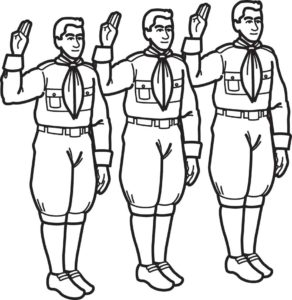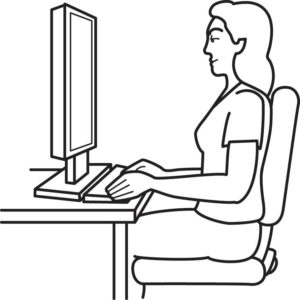
In this blog I’ll review and critique standing, sitting and lying posture instruction from another politically correct or formal Type 1 discipline: acatoday.org, (American Chiropractic Association)
Although they have become more right in many respects, the ACA is still instructing incorrectly, or according to Type 1 guidelines in numerous details. I’ll point them out as we move along. Start off with their definition:
What is posture?
Posture is the position in which we hold our bodies while standing, sitting, or lying down. Good posture is the correct alignment of body parts supported by the right amount of muscle tension against gravity. Without posture and the muscles that control it, we would simply fall to the ground.
My problem with ACA’s definition is that they still imply posture is static, as suggested by use of the words “position”, “hold”, and “control it”. From a Type 1 outlook this may be right, but there is no mention of movement or balance here. No mention of a naturally balanced positioning. No mention of where this position is or how to find it.
ACA continues: Normally, we do not consciously maintain normal posture. Instead, certain muscles do it for us, and we don’t even have to think about it. Several muscle groups, including the hamstrings and large back muscles, are critically important in maintaining good posture. While the ligaments help to hold the skeleton together, these postural muscles, when functioning properly, prevent the forces of gravity from pushing us over forward. Postural muscles also maintain our posture and balance during movement.
The use of the words “several muscle groups” including the”large back muscles” is wrong from a Perfect Posture standpoint. It implies holding the back “up straight” with the “large back muscles”. The back muscles should be relaxed with the upper body balanced upon the hamstrings, legs, buttocks or whatever you want to call the leg muscles.

Early Imprinting
The use of the word “maintain” three times, suggests a static position. It appears to be a reference to type 1 or formal posture that is to be held and maintained to stay “normal”.
Most in the west don’t have to “consciously maintain normal posture” because we have been conditioned to subconsciously think “it” is “normal”. We hold “it” (Type 1) subconsciously.
ACA goes on to say: To maintain proper posture, you need to have adequate muscle flexibility and strength, normal joint motion in the spine and other body regions, as well as efficient postural muscles that are balanced on both sides of the spine. In addition, you must recognize your postural habits at home and in the workplace and work to correct them, if necessary.
The ACA is about halfway there. They instruct that “you need to have adequate muscle flexibility and strength”. Which muscles? “as well as efficient postural muscles that are balanced on both sides of the spine. What are the “postural muscles”? How do you find this balance? Salutations in this instance for recognizing the need for balance.
How do I sit properly?
- Keep your feet on the floor or on a footrest, if they don’t reach the floor.
- Don’t cross your legs. Your ankles should be in front of your knees.
- Keep a small gap between the back of your knees and the front of your seat.
- Your knees should be at or below the level of your hips.
- Adjust the backrest of your chair to support your low- and mid-back or use a back support.
- Relax your shoulders and keep your forearms parallel to the ground.
- Avoid sitting in the same position for long periods of time.

These are Type 1 instructions. You should sit in a straight backed chair only when in a formal or Type 1 situation. School, court, the military etc.
There is no mention that sitting up straight in a straight back chair becomes harmful rapidly, or that our bodies are not designed for this position. Why should your back need “support” to sit “properly” or naturally?
How do I stand properly?
- Bear your weight primarily on the balls of your feet.
- Keep your knees slightly bent.
- Keep your feet about shoulder-width apart.
- Let your arms hang naturally down the sides of the body.
- Stand straight and tall with your shoulders pulled backward.
- Tuck your stomach in.
- Keep your head level-your earlobes should be in line with your shoulders. Do not push your head forward, backward, or to the side.
- Shift your weight from your toes to your heels, or one foot to the other, if you have to stand for a long time.
ACA is getting better. They instruct to “bear weight primarily on the balls of you feet and keep your knees slightly bent”. Good instruction. But the ACA then instructs: “stand straight and tall with your shoulders pulled backward”. How do you let your arms hang naturally down the sides of you body” while your shoulders are held back? Inconsistent, confusing.
ACA instructs to “Tuck your stomach in”. There are many websites on the internet stating the dangers of “tucking” or holding the stomach in. There are many who say it is not dangerous. Why risk the dangers? With Perfect Posture methods it is unnecessary, as the body, including the stomach, has a natural muscle tonus flowing through it without effort.
See these websites for more on “dangers of holding the stomach in:
http://www.dagmarkhan.com/dangers-sucking-belly/
https://www.quora.com/Is-it-bad-to-hold-in-your-belly-fat-throughout-the-day
What is the proper lying position?
- Find the mattress that is right for you. While a firm mattress is generally recommended, some people find that softer mattresses reduce their back pain. Your comfort is important.
- Sleep with a pillow. Special pillows are available to help with postural problems resulting from a poor sleeping position.
- Avoid sleeping on your stomach.
- Sleeping on your side or back is more often helpful for back pain. If you sleep on your side, place a pillow between your legs. If you sleep on your back, keep a pillow under your knees.
I have no issues with the ACA’s instruction for proper sleeping position. If you’re looking for a position most likely to relieve back pain immediately, or in the future, I would recommend the Perfect Posture method as stated in this blog titled “How To Lay For Back Pain Relief and Proper Posture”.

